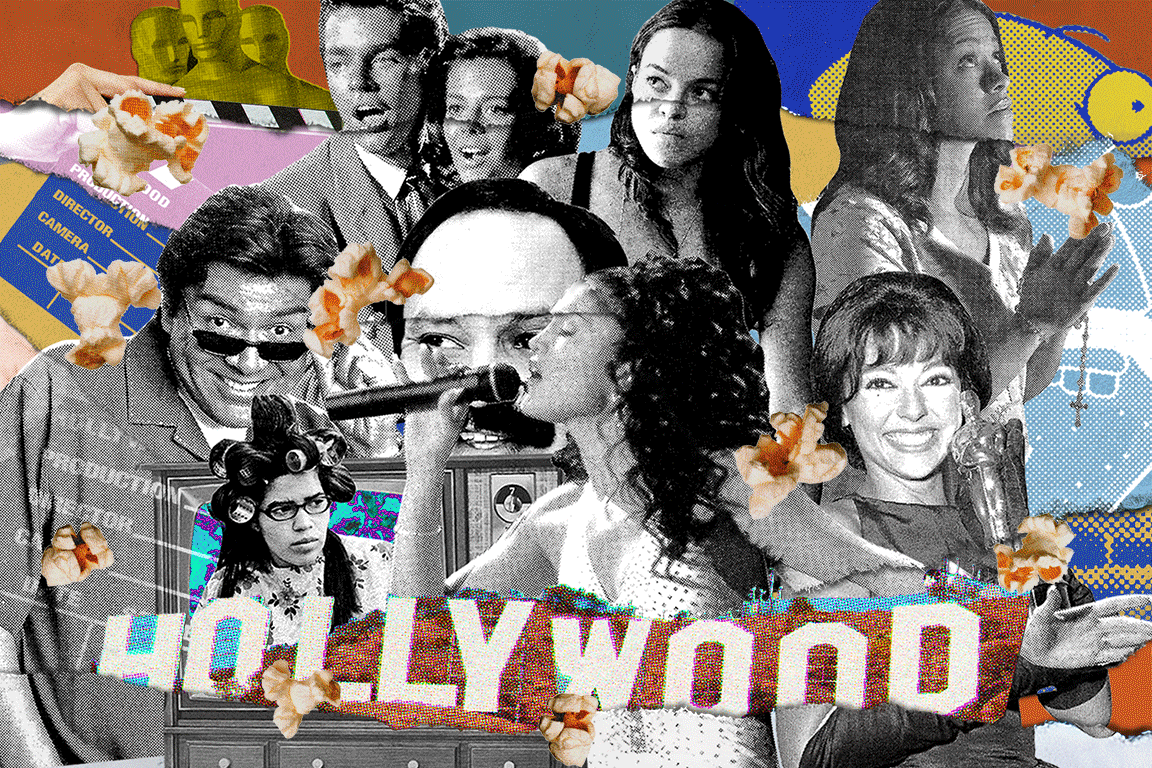The complete guide to home viewing
Get Screen Gab for everything about the TV shows and streaming movies everyone’s talking about.
You may occasionally receive promotional content from the Los Angeles Times.


SPECIAL REPORT
Hollywood's Latino Culture Gap
Times journalists examine the complicated history of Latinos in Hollywood and the actions being taken to increase their representation, which remains stubbornly low. FULL COVERAGE
What was supposed to be Gladys Rodriguez’s dream job began in early 2019. The TV writer, then 37, received a call about consulting on a new Netflix series focused on the life of Tejano pop superstar Selena Quintanilla. Having a hand in retelling the story of a cherished Latino icon who achieved the American dream for the biggest streaming platform in the world? Of course Rodriguez had to be a part of it. Anything for Selena. Or so she thought.
“I should have seen these red flags in the beginning,” Rodriguez says.
“Selena: The Series” follows the rise of the young Mexican American singer from South Texas who leaned into her roots and learned Spanish phonetically to sing Tejano music, achieving mainstream success that has endured long past her untimely death in 1995.
It’s an intrinsically American story that seemed primed to join Netflix’s roster of big-budget U.S. originals. Instead it was ordered as a Latin American original, with a modest budget to match — well under $2 million per episode, according to multiple sources, for a period drama with specific costume, makeup and set needs. “The Crown,” by comparison, cost a reported $13 million per episode at launch. (“Selena” viewers criticized the series’ apparent budgetary limitations on social media.)
“Selena: The Series” turns the focus to the men behind her — creating a self-serving, controlled narrative that fails to illuminate the late singer herself.
“The show sort of experienced what Selena experienced,” said Henry Robles, who served as a co-executive producer on the series. “From the beginning, she wanted to sing in English. But people didn’t know what to do with her. The music industry didn’t know how to categorize [her] or they expected certain things of her because she was Mexican American. And it’s similar to this show.” (A spokesperson for Netflix told The Times that the Latin American originals team actively pursued the project, and ordered “Selena” to series because of the singer’s continuing popularity in Mexico.)
The Writers Guild of America sets rules for minimum rates of writer compensation on streaming series based on episode length, episodic budget and the number of subscribers to the platform. Because “Selena’s” budget fell below the guild’s then-threshold of $2.5 million per episode for one-hour “high-budget” series on platforms with more than 20 million subscribers — a category that includes much of Netflix’s programming — different WGA rules for minimum pay applied.
This enabled the production to negotiate writers’ pay lower than the “high-budget” minimums set by the WGA: Multiple “Selena” staffers who did not want to discuss their pay publicly in absolute terms disclosed that they made between 30% and 50% per week less working on the series, which was filmed in Mexico, than is typical for equivalent roles on those produced in the U.S.
A Netflix spokesperson said the company believes the writers were compensated fairly based on quotes negotiated by their U.S. representation.
The pay was especially startling, the writers said, given their demanding schedule, which took a page from the telenovela workflow: They were expected to complete the two seasons, totaling 18 episodes, in roughly 20 weeks, a time frame more typical for turning around eight to 10 episodes. The schedule was eventually extended by four months.
Tomorrow, Netflix releases the first nine episodes of “Selena: The Series,” chronicling the road to stardom for the Tejano queen and her family band Los Dinos. Retelling her iconic story is no easy task.
Their love for Selena, the writers said, drove them to take the job despite the low wages, but all expressed frustration at the disrespect they say they felt being underpaid and overworked for a series that quickly dominated Netflix’s own top-10 charts in 23 countries following its December 2020 release. Though Netflix does not disclose total viewership numbers, it says half of “Selena’s” audience came from the U.S., where it spent its first week in the streamer’s No. 1 spot.
“We knew ‘Selena: The Series’ could be a huge hit, so we were very saddened when we pitched it to several traditional networks in Hollywood and no one bought it,” Jaime Dávila, president/co-founder of Campanario Entertainment, which produced the series, said in a statement to The Times. “When Netflix came into the picture, we were thrilled that the biggest global platform saw the potential of a series about a cultural icon whose reach transcends borders and cultures.”
Rodriguez, who was credited as a co-executive producer on the series, says she feels like she has “a little bit of PTSD” from the show: “I feel like our work was cheapened from the start. We were never given a fair chance. ... Representation is what we want but it goes beyond that — we want to be treated equally.”
Showrunner Moisés Zamora calls the experience “a learning lesson.” “The fact that we were able to get 14 Latinx writers to take on this thing, with all the challenges we faced … my goal is to continue making the case that our stories are worth telling — they deserve as much as any other production,” he says. “I’m really proud that we got to make an incredible show given what we were given.”
Launched by Tanya Saracho’s United Latinx Project, the letter, signed by more than 270 Latinx creatives, calls Hollywood “complicit in our exclusion.”
That the apparent success of “Selena: The Series” hid such disappointment for a number of those who participated in its making is a poignant illustration of the obstacles Latino storytellers face in getting their stories on screen.
Today, Latinos comprise more than 18% of the U.S. population but, despite the dramatic surge in the number of platforms and series, account for only 8.7% of TV writers, according to a 2020 Writers Guild of America study — making them the most underrepresented ethnic group across TV writing jobs in relation to their share of the population.
The Times spoke with more than a dozen Latino writers in television about their efforts, in both their work and their activism, to transform Hollywood’s culture. Though the industry has awoken to the importance of diversity and inclusion in recent years, it remains notorious for stifling career growth for underrepresented groups in behind-the-scenes roles, while retaining the power to broaden and shape public views of Latinos with the portrayals it allows on screen.
Rehashes such as “Charmed” and “One Day at a Time” put Latinos on TV. But narratives wholly shaped by Latino points of view are much harder to find

A 2019 Pew Research Center study found that 58% of Hispanic adults said they’ve experienced discrimination or have been treated unfairly because of their race or ethnicity. Across racial and ethnic groups, about two-thirds said that it became more common for people to express racist views once Donald Trump became president.
Latinos in Hollywood are in what “Vida” showrunner Tanya Saracho calls “the fight to exist”: “The way [Latinos] are valued in America as a whole is how we’re valued by Hollywood, the industry. How do we fix that?”
Linda Yvette Chavez, co-creator of Netflix’s “Gentefied,” says it’s incumbent on Hollywood to do the work.
“Just like the government has a responsibility to the communities that it has historically disenfranchised, Hollywood, an industry that has perpetuated such negative stereotypes and horrible depictions of us since very early in its inception, [has] a very true responsibility to create content by and for these communities, whether or not it performs at the numbers or creates the financial gain that they’re looking for,” she says. “It’s restorative justice.”
A Times analysis has found that Latino representation in film and TV has stagnated for a decade-plus, even as Latinos’ share of the population has grown.
Though data showing the dearth of Latino representation in U.S. popular culture is well known, the writers who spoke to The Times elaborated on the qualitative aspects of the problem, identifying several main themes, including:
The lower-level diversity trap. Many Latino writers feel stuck — and begin to stagnate — in entry-level roles and a pipeline of diversity initiatives that can feel more limiting than liberating. “You keep getting hired as a lower-level writer because you’re free to the show,” says “Queen of the South” co-showrunner Dailyn Rodriguez, referring to the practice by which companies cover the salaries of diversity program participants without counting those costs against the series’ budget. “You keep getting stuck in this lower level. And it’s hard to go up. So there’s less of us on the upper levels.”
This list only scratches the surface of the obstacles Latino writers face in trying to move Hollywood’s rusty needle. But television’s leading Latino writers would rather focus on action.
Hollywood’s history with Latino representation is a muddy mess. Why even Washington politicians are taking action.

The parity problem is so glaring that Saracho founded an all-Latina advocacy group called the Untitled Latinx Project (ULP) in an effort to raise awareness and increase the number of Latinx-created stories on television: “In community, we get strength,” Saracho says.
The group released an open letter to Hollywood on the final day of October, which is National Hispanic Heritage Month. Featuring signatures from 276 Latino creatives, including Eva Longoria, Lin-Manuel Miranda and John Leguizamo, the letter said, “Hollywood power brokers are complicit in our exclusion” and laid out a list of demands, including a call to hire more Latinx writers, especially in decision-making roles like creator/showrunner. “No stories about us without us,” it read.
Representatives from United Talent Agency connected with organizers to set up a meeting, Saracho said, but there was no outreach by the studios or networks.
ABC, CBS, NBC and Fox have pledged to improve diversity in the wake of the Black Lives Matter movement. It’s the latest chapter in a decades-long struggle.
“When we sat down with UTA, we were like: ‘Why don’t they produce our s—? As people who are sellers of our talent, explain to us,’” Saracho says. “One of them said: ‘You guys don’t make enough noise.’ It is in us — look at the immigration marches. We have to shift our paradigm. We need to sit down and have those conversations.”
Plans are underway for another action by ULP organizers to speak with studio heads. Part of the issue, “One Day at a Time” co-showrunner Gloria Calderón Kellett says, is establishing singular voices who carry the sort of power that demands attention.
“We don’t have that major voice for the Latino community yet,” she says. “We don’t have an Ava [DuVernay] or a Shonda [Rhimes]. We’re building that. Tanya and I are trying to be that. I wish that I had the resources. The problem is I’m trying to run a new show. I don’t have the time to do that. Tanya, too, is trying to get her next show up and running. We’re trying to find time in between all of this stuff to like have meetings and say, ‘OK, well, how do we follow up on the letter? How do we sit down with people when we don’t have time to step away from a writers room?’ Thank God for people like America [Ferrera] and Eva [Longoria], they’re the closest we have.”
Even fresh off the run of the groundbreaking FX series “Pose,” which he co-created with power producing partners Ryan Murphy and Brad Falchuk, Steven Canals says his visibility does not equate to more power.
“I’m still on the other side of the door, trying to push it open, just like everybody else,” he says. “The heartbreaking part of acknowledging that is a lot of young or nascent writers will reach out, and they don’t get the response that they’re hoping for. Sometimes I walk away feeling like, ‘F—, I really hope that they don’t think that I’m not wanting to help the community, that it’s all just lip service, that outwardly, we’re saying: ‘I want to help everybody’ and then behind the scenes, we really don’t give a s—. Because the truth is , we really do want to help. We just don’t have all the power that you’re assuming that we do.”
Many of the enduring issues could be mitigated, the writers said, if there were more people of color working as executives, agents and in other decision-making positions to combat the industry’s entrenched whiteness. In a 2020 analysis of executive positions at TV networks and film studios, UCLA’s “Hollywood Diversity Report” found just 20 Latino TV executives out of 919, or 2.1%, with none at the CEO/chair level, and exactly zero Latino film executives, out of 170.
Calderón Kellett recalled a situation about the creative direction for key promotional art for “One Day at a Time,” which was produced by Sony Pictures Television and premiered on Netflix before moving to Pop TV in 2020.
“They said, ‘Oh my God, we have a great idea for a poster, Gloria, you’re going to freak out: family food fight,’” she says. “‘It’s rice flying across, everyone’s covered in food, and they’re laughing.’ And I said, ‘Hell no. Abuela has made that food for hours and you’re throwing that food? We don’t waste food. What are you talking about? Latinos throwing food?’ But it’s all white people pitching me. Half of my job is explaining.”

Some writers have signed overall deals or formed production shingles to keep the content and talent pool wide. Calderón Kellett recently signed an overall deal with Amazon Studios; last year, Saracho launched Ojalá Productions; and Zamora co-founded Zone One, to name a few.
“I just wanted to get to a place where I could be able to tell stories to a lot of people and make a difference,” says Zamora. “Because once you achieve a dream, what happens after that? You pass it on, you share it, you help others achieve the dream.”
Lasting change, many of the writers said, would feel like a reality when stories featuring Latinos or the Latino experience become ubiquitous enough that they don’t have to be slapped with a “Latino” modifier —”Latino family sitcom,” “Latino-centric,” “Latino reboot” — or when the stories don’t always have to center on identity.
Mostly, they just want to see the Latino narrative evolve more substantially beyond depictions that have long stereotyped the community: stories that center on crime or Latino trauma, particularly as it relates to immigration. While those stories have value when handled by Latino creatives, the writers say, the time is overdue for more layered depictions that are universal enough for non-Latinos to see themselves in.
Hollywood’s most influential showrunners talk with The Times about how they broke into the business, the shifting TV landscape, their writing process and more.
As Marvin Lemus, the co-creator of Netflix’s “Gentefied,” puts it: “I want to have the audacity to tell a weird story that features brown characters … in the vein of the Coen brothers.”
“Half their movies don’t make any sense and I love them,” he added. “I want that privilege of being able to approach my storytelling that way, and not having to hold the audience’s hand with, like, ‘Let me teach you what it’s like to be a brown person.’”
Ilana Peña, the creator of “Diary of a Future President” on Disney+, has big ambitions too: “I want our sci-fi, I want our ‘Bridgerton.’ I want to be able to just make fun comedies or family dramas. I haven’t seen Latinx joy on screen enough. And I think that’s why the loss of ‘One Day at a Time’ was so emotional. I want to turn on the TV and see a character who has, you know, similar experiences to mine or my family or my friends.”
This frustration is at the heart of the discouragement expressed by the writers on “Selena: The Series.” If the dramatic true story of one of Latino culture’s most visible crossover successes, and a likely global hit, is made faster and more cheaply than many of its competitors, they suggested, what chance do more idiosyncratic projects by Latino creators have of breaking through?
Still, while Hollywood’s Latino problem might seem intractable today — particularly for the veteran TV writers who feel like they’ve heard it all before — the majority of those interviewed for this story remain cautiously optimistic that Hollywood’s Latino culture gap will narrow.
“I’ll tell you what gives me hope: that I’m surrounded by enough people in my life who are fighting the good fight,” Canals says. “In my lifetime, I think we’ll see a shift. I don’t know that it’ll be as grand as we’re hoping for it to be. Not yet. But that’s OK. I’m hopeful that all the conversations we’re having, and the progress that we’re making, the shows that we’re creating, that all the pushing that we are doing, the being on the front line of this fight and being vocal, that it will create a movement. Even if I don’t get to benefit from it, we’ll do it for the next generation.”
The complete guide to home viewing
Get Screen Gab for everything about the TV shows and streaming movies everyone’s talking about.
You may occasionally receive promotional content from the Los Angeles Times.